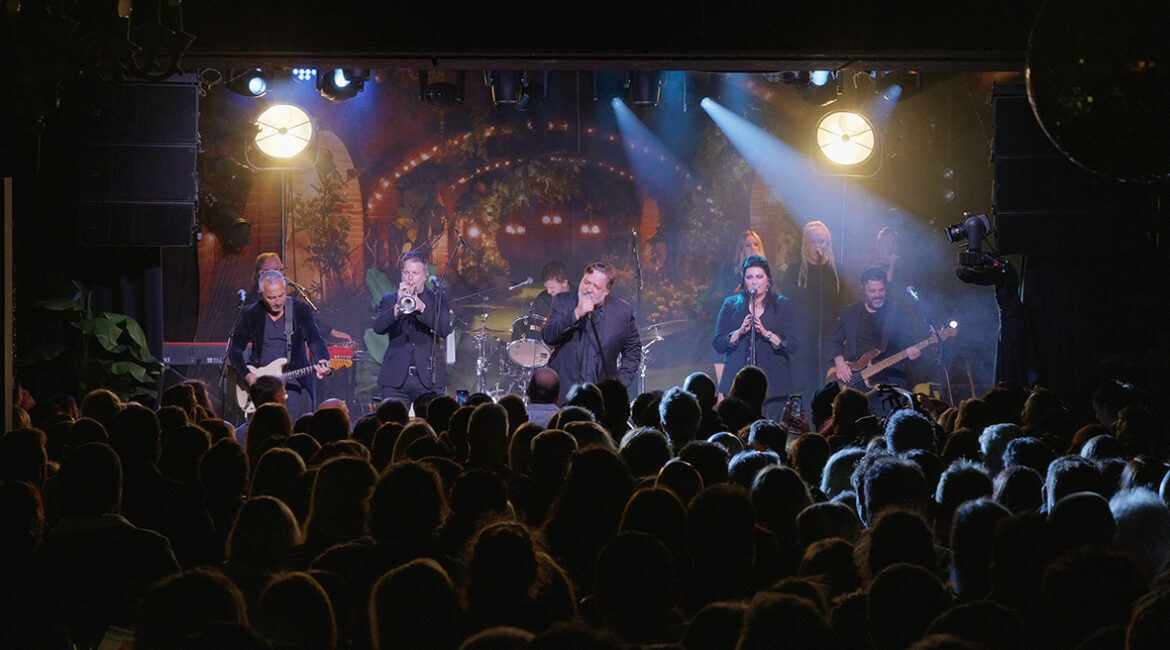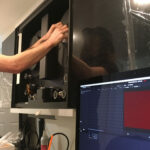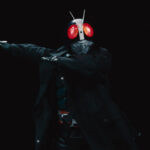Russell Crowe’s Indoor Garden Party tour featured 17 shows around the east coast of Australia, as well as multiple shows in Malta, Italy and the Czech Republic. The venues ranged from small pubs and clubs to large theatres and festivals. These included iconic venues The Sydney Opera House and Australia Zoo and world-renowned events such as The Karlovy Vary International Film Festival. The entire tour was captured exclusively by and shot with Sony cameras.
Director of photography on the tour, Joe Machart, explained, “Russell wanted six or more cameras on every show, as well as the ability for us to record rehearsals, interviews and behind the scenes footage. Over the years my go-to camera kit has gone from the Sony HDR-FX1 to the NEX-FS100 to the PXW-FS5 to the ILME-FX6V. When Sony announced the ILME-FR7, I was very excited to see what possibilities it would unlock for the tour. Sony and their partner distributor, Lemac, kindly organised a demo of one of the first units in Australia.”
Before the tour began, Crowe tasked award-winning DoP Jules O’Loughlin ACS ASC and Machart with organising the filming of two earlier concerts he was planning at The Hoey Moey in Coffs Harbour.
Machart added, “This venue provided a fantastic experience for live acts and Russell wanted to capture that in the footage. On our recce we discovered that our wide and mid shots at front of house would be obstructed by a low ceiling. The FR7 immediately came to mind as an elegant solution as there was a lighting bar over the mosh pit which we could under-sling this camera on. This gave us a clear angle of the stage and worked flawlessly.”
As Machart mentioned, there were some very specific creative requirements that had to be met by the Sony cameras on the tour. For example, all cameras needed to have a similar look so that colour correcting would be easy – something that was particularly important as content was to be edited quickly on the road.
Machart said, “We also only had a camera team of three people and we had to keep our gear to a limited size, so as not to have large builds at every venue.”
To help him on the tour Machart worked with two old friends and “amazing cinematographers”, Nick Hodgskin and Scott Wood – both big fans of the Sony Cinema Line.
Machart added, “The Sony Cinema Line was the only choice that met all of our requirements. I chose to utilise an FX6, four FX3s, three FR7s and an A7RV. They all have S-Gamut3.Cine/S-Log3 profiles and can be effortlessly matched in the grade. The versatility of the whole Sony Cinema Line meant that we could use each camera’s strengths to our advantage. Russell saw the potential of the FR7s from the early gigs as a way that one person could operate three cameras simultaneously. The FX3s are extremely compact, allowing for comfortable and prolonged shooting. They also have IBIS for smooth movements. The FX6 has ergonomic controls as well as built in variable ND. The speed and durability of Sony’s CF Express Type A cards were essential. We had quick turnaround times in between shows and these cards enabled us to data wrangle footage onto mirrored SSDs in minimal time.”On the Russell Crowe Indoor Garden Party tour the FR7 operator desk typically had three iPads to monitor and control settings. Machart described the set-up as “very intuitive” and enjoyed the fact that the crew were able to use the touch screen to focus, move the camera and change settings.
He continued, “The Sony RM-IP500 allowed for finer tuned controls with the joystick and dials. The ability to recall position presets and determine the speed of the movements created dynamic, replayable shots at the touch of a button. One person could control one camera with the RM-IP500, whilst also controlling a second or third camera simultaneously with presets or the iPad interface. It was a treat to use autofocus on a slow speed setting to rack focus between subjects on stage with just a touch on the iPad.”
According to Machart, another great feature was the live monitoring page which showed a full screen live feed, without the ability to control the camera. He explained, “This feature became invaluable for us as we could use our phones to wirelessly connect to the FR7 router, allowing us to remotely view a shot whilst setting up. We placed an iPad in Russell’s green room so that he could direct our shots, as well as view what was happening on stage.”
The tour always had a mega deck riser at the back of the room with an FX6 and an FX3 on tripods. The FX3 was a locked off wide with a 24-70mm SEL2470GM2 and the FX6 was a mid shot with a 100-400mm SEL100400GM (sometimes with a doubler SEL20TC) and operated by one of the crew. The FX6 also took in left and right audio channels of the line mix from the sound desk.
Machart said, “It was very helpful that the FX6 could also record scratch audio tracks on channels 3 and 4 just in case anything unexpected happened with the sound desk feed. We used an FX3 on an Easyrig or DJI RS3 Pro gimbal to get dynamic shots from within the crowd and around the stage. Russell likes movement in his shots and a feeling of being part of the audience, which these setups achieved. We rigged other FX3s in interesting positions using magic arms, usually on stage somewhere or at high vantage points. We could confidently put these cameras in places which aren’t possible to access during a show, thanks to the remote control function of the Sony’s Creators’ App. This app enabled us to remotely access and view an FX3.”
Sometimes, Crowe would have interviews to do for live broadcast, radio or Zoom® where the crew would then use their FX6 with an iPad teleprompter rigged to it. The iPad was a mirrored display for Machart’s MacBook Pro via Sidecar so that Crowe could see the live studio feed on the teleprompter while he maintained his eyeline down the lens of the camera.
Machart added, “We either used a LiveU, cellular hotspot or Starlink dish to send and receive data with low latency, even in remote areas. The S-Cinetone picture profile was perfect for these situations as the colours and skin tones look accurate and cinematic.”
As this whole tour formed part of an inside look at Russell Crowe’s music life, he also wanted to film rehearsals and the recording of new songs in his music studio. With the musicians and their instruments filling the space, there wasn’t much room left for camera operators. Again, Machart saw the FR7s as the perfect solution for this situation.
He explained, “We placed three FR7s around the studio and ran Ethernet cables to an operator’s desk in an adjacent room. Not only did this reduce our footprint in the room, but it also allowed the musicians to not feel pressured by the presence of cameras. The FR7’s full frame sensor allowed us to achieve cinematic, shallow depth of field shots with amazing low light performance and 4K resolution.”
In terms of a typical workflow on the tour, Machart and the crew started by using the FX6 to jam timecode into all cameras. They then typically chose positions for their three FR7 cameras. With the Progl+Gerlach PGX FR7 mounting plates, they had a variety of mounting points and an easy 4mm safety chain solution. They also travelled with a selection of grip gear which gave them flexibility to mount the FR7s in different ways.
He continued, “We decided that the most versatile way to mount the FR7s at venues would be with half clamps because they gave us the option to mount the camera upright or underslung. In this way, we could rig FR7s onto existing lighting bars in venues, or onto our own scaff posts and steel stands with T speed rails. We plugged our FR7s, iPads and RM-IP500 into a network switch and router. All cameras then appeared on the network and could be controlled without much setup. Over the duration of every four-hour show we did not have a single issue with an FR7 not responding. The dual slots on the FR7 allowed for ample storage space. After the show concluded a roaming FX3 followed the band back to the green room to capture behind the scenes.”
It’s clear that Machart is a big fan of Sony cameras and in particular the results they helped him achieve on the Russell Crowe’s Indoor Garden Party tour. He said, “Sony is a market leader in its colour science, autofocus and low light performance. It was invaluable to have a family of cameras, each with different strengths to meet every situation. When we filmed at large venues we sometimes attracted a small crowd at the back of the room trying to get a glimpse of our FR7 iPad screens to watch the performance. The FR7s truly gave unique and impressive angles of the stage. The low light performance, dual base ISOs and the ECS shutter mode of the FX6 and FR7 were crucial with the dynamic and challenging stage lighting.”
Machart continued, “The high dynamic range of these cameras in CineEI mode also gave us the confidence of knowing that the shadows and highlights were protected. Typically, there were areas on stage with bright follow spots and other areas of deep shadows. Preserving all these details was essential in producing the best image possible. The autofocus on these cameras is truly remarkable. The facial recognition continued to lock focus to a subject’s eye in the constantly changing lighting and movement of the musicians. The autofocus allowed us to concentrate on controlling the PTZ functions and composing the shots. Likewise, the facial recognition autofocus became an essential part of a one-person gimbal setup for these concerts. Without worrying about focus, the operator was free to compose the shot. The FR7 was also small enough that it could offer angles and perspectives which would previously have been impossible to get with a large sensor cinema camera.”
The high frame rate options of the Sony cameras additionally enabled Machart and the crew to capture emotion and energetic movements in engaging slow motion. The ability to take all camera angles into the edit and have minimal colour correcting before the grade was also a great time saver for the tour.
The tour finished with a performance at the Karlovy Vary International Film Festival in the Czech Republic. With the help of local production companies and crew the final show was filmed with 19 cameras in front of 15,000 people.
Machart had one final point to make about the success of the cameras and the resulting success of the tour and he saved that for Sony and the team at Sony Australia. He said, “It’s clear that Sony is committed to the highest standards of sales, service and support. They definitely listen to feedback from their community. Kenan Sarac at Sony Australia was outstanding in bridging the gap between a big company and its customers. I particularly like how Sony and Lemac work together to ensure that the customer has a positive experience and custom solutions. It’s been a real pleasure to use the Sony Cinema Line to film a large project and it has further reinforced my confidence in these exceptional cameras.”






